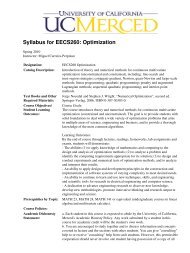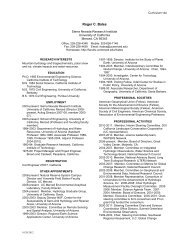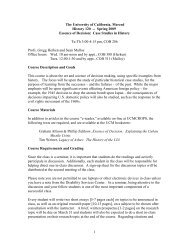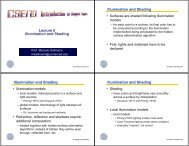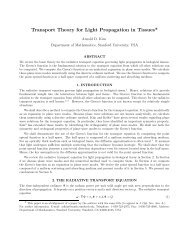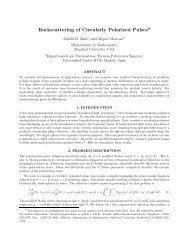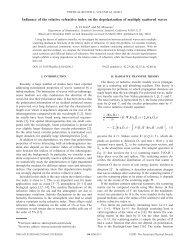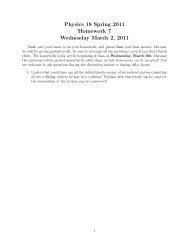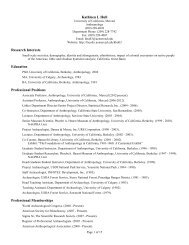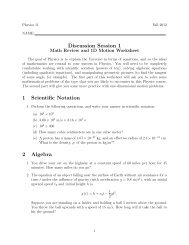Physics 18 Spring 2011 Homework 12 - Solutions Wednesday April ...
Physics 18 Spring 2011 Homework 12 - Solutions Wednesday April ...
Physics 18 Spring 2011 Homework 12 - Solutions Wednesday April ...
Create successful ePaper yourself
Turn your PDF publications into a flip-book with our unique Google optimized e-Paper software.
<strong>Physics</strong> <strong>18</strong> <strong>Spring</strong> <strong>2011</strong><br />
<strong>Homework</strong> <strong>12</strong> - <strong>Solutions</strong><br />
<strong>Wednesday</strong> <strong>April</strong> 13, <strong>2011</strong><br />
Make sure your name is on your homework, and please box your final answer. Because<br />
we will be giving partial credit, be sure to attempt all the problems, even if you don’t finish<br />
them. The homework is due at the beginning of class on <strong>Wednesday</strong>, <strong>April</strong> 20th. Because<br />
the solutions will be posted immediately after class, no late homeworks can be accepted! You<br />
are welcome to ask questions during the discussion session or during office hours.<br />
1. The wave function for a harmonic wave on a string is y(x, t) = (1.00 mm) sin(62.8 m −1 x+<br />
314 s −1 t).<br />
(a) In what direction does this wave travel, and what is the wave’s speed?<br />
(b) Find the wavelength, frequency, and period of this wave.<br />
(c) What is the maximum speed of any point on the string?<br />
————————————————————————————————————<br />
Solution<br />
Recall that our usual expression for a wave is<br />
y(x, t) = A sin (kx ± ωt + δ) ,<br />
where A is the amplitude, k = 2π/λ is the wave number, ω = 2πf is the angular<br />
frequency, and δ is a phase shift. We’ll use this form to answer our questions.<br />
(a) Because the coefficient of the time is positive, the wave travels to the left. It’s<br />
speed is just ω/k = 314/62.8 = 5 m/s.<br />
(b) The wavelength is λ = 2π/k = 2π/62.8 = 0.10 meters. It’s frequency is f =<br />
ω/2π = 314/2π = 50 Hz, which gives a period of T = 1/f = 1/50 = 0.02 seconds.<br />
(c) The maximum speed of any point on the string is just the amplitude of the time<br />
derivative of the wave function (the velocity), which is Aω. So, vmax = Aω =<br />
0.001 × 314 = 0.314 m/s.<br />
1
2. You have just been pulled over for running a red light, and the police officer has<br />
informed you that the fine will be $250. In desperation, you suddenly recall an idea<br />
that your physics professor recently discussed in class. In your calmest voice, you tell<br />
the officer that the laws of physics prevented you from knowing that the light was red.<br />
In fact, as you drove toward it, the light was Doppler shifted to where it appeared<br />
green to you. “OK,” says the officer, “Then I’ll ticket you for speeding. The fine is $1<br />
for every 1 km/hr over the posted speed limit of 50 km/hr.” How big is your fine? Use<br />
650 nm as the wavelength of red light and 540 nm as the wavelength of green light.<br />
————————————————————————————————————<br />
Solution<br />
Since we are approaching the the light, the wavelengths are shortened due to the<br />
Doppler shift. The decrease in the wavelength is given by<br />
<br />
c − v<br />
λ =<br />
c + v λ0<br />
<br />
1 − v/c<br />
=<br />
1 + v/c λ0.<br />
Once again, we can solve for the velocity as<br />
v<br />
c = λ20 − λ2 λ2 .<br />
0 + λ2 Taking λ0 = 650 nm and λ = 540 nm, we find<br />
v<br />
c = λ20 − λ2 λ2 0 + λ2 = 6502 − 5402 6502 = 0.<strong>18</strong>3.<br />
+ 5402 Thus, the velocity is v = 0.<strong>18</strong>3c ≈ 55.5 × 10 7 m/s, which is about 2 × 10 8 km/hr. This<br />
is well above the posted speed limit of 50 km/hr, and so the fine would basically be<br />
$200 million!!! You’re far better off just paying the $250 fine for running the red light!<br />
2
3. In the oceans, whales communicate by sound transmission through the water. A whale<br />
emits a sound of 50.0 Hz to tell a wayward calf to catch up to the pod. The speed of<br />
sound in water is about 1500 m/s.<br />
(a) How long does it take the sound to reach the calf if he is 1.20 km away?<br />
(b) What is the wavelength of this sound in the water?<br />
(c) If the whales are close to the surface, some of the sound energy might refract out<br />
into the air. What would be the frequency and wavelength of the sound in the<br />
air?<br />
————————————————————————————————————<br />
Solution<br />
(a) This is just a simple velocity times time problem, so t = d/v = <strong>12</strong>00/1500 = .8<br />
seconds.<br />
(b) Since the velocity is the product of the wavelength and the frequency, then λ =<br />
v/f = 1500/50 = 30 meters.<br />
(c) The frequency doesn’t change as we go from one medium (water) to another<br />
(air), and so the frequency of the wave is still the same 50.0 Hz. Now, the<br />
velocity of the sound wave is much slower, vair = 343 m/s. So, the wavelength is<br />
λ = v/f = 343/50 = 6.86 meters.<br />
3
4. In modern medicine, the Doppler effect is routinely used to measure the rate and<br />
direction of blood flow in arteries and veins. High-frequency “ultrasound” (sound<br />
at frequencies above the human hearing range) is typically employed. Suppose you<br />
are in charge of measuring the blood flow in a vein (located in the lower leg of an<br />
older patient) that returns blood upward to the heart. Her varicose veins indicate that<br />
perhaps the one-way valves in the vein are not working properly and that the the blood<br />
is “pooling” in the veins and perhaps even that the blood flow is backward toward her<br />
feet. Employing sound that has a frequency of 50.0 kHz, you point the sound source<br />
from above her thigh region down toward her feet and measure the sound reflected<br />
from that vein area to be lower than 50.0 kHz.<br />
(a) Was your diagnosis of the valve condition correct? If so, explain.<br />
(b) Estimate the instrument’s frequency difference capability to enable you to measure<br />
speeds down to 1.00 mm/s. Take the speed of sound in flesh to be the same as<br />
that in water, 1500 m/s.<br />
————————————————————————————————————<br />
Solution<br />
(a) Because the reflected frequency was lower than the emitted frequency, we know<br />
that the source was moving away from you. This means that the blood wasn’t<br />
coming back up the veins to the heart, and so your diagnosis is correct.<br />
(b) When we first emit the pulse, the blood is moving away from us. This results in<br />
a shift received by the blood,<br />
fR =<br />
v<br />
fS,<br />
v − uS<br />
where uS is the velocity of the blood. This, then, results in a shifted source<br />
frequency, fR, that is reflected back as us, leading to a second Doppler shift. We<br />
get a new frequency, f ′ R . Since the source is moving away from us, the reflected<br />
frequency is given by the Doppler shift as<br />
f ′ R = vfR<br />
v − uS<br />
=<br />
v2 2 fS,<br />
(v − uS)<br />
So, the difference in frequency is ∆f = f ′ R − fS, or<br />
<br />
∆f = 1 − v2<br />
<br />
(v−uS) 2 fS<br />
−2vus+u2 s<br />
(v−us) 2 fS<br />
=<br />
−2vus<br />
≈<br />
(v) 2 fS<br />
= −2 us<br />
v fS,<br />
where we have recalled that v ≫ us in the last two lines. So, plugging in the<br />
values gives<br />
∆f = −2 us<br />
v fS = −2 0.001 3<br />
50 × 10<br />
1500<br />
≈ −0.067 Hz.<br />
4
5. A bat flying toward a stationary obstacle at <strong>12</strong>.0 m/s emits brief, high-frequency sound<br />
pulses at a repetition frequency of 80.0 Hz. What is the interval between the arrival<br />
times of the reflected pulses heard by the bat?<br />
————————————————————————————————————<br />
Solution<br />
Because the bat is getting closer the frequency with which it receives the reflected<br />
pulses is increasing, meaning that the period between the reception of those pulses is<br />
going down. The time between pulses is just the inverse of the received frequency,<br />
∆t = 1/fR. Now, using the Doppler shift formula we can relate the received frequency<br />
to the source frequency. Since the bat is approaching the “source” (the reflecting wall)<br />
we have<br />
fR =<br />
v + uR<br />
fS,<br />
v − uS<br />
where v is the speed of the wave, uR = uS = <strong>12</strong>.0 m/s is the speed of the bat, and fS<br />
is the frequency of the sound emitted by the bat. So, since ∆t = 1/fR, we have<br />
∆t = 1<br />
=<br />
fR<br />
v − uS<br />
<br />
1 343 − <strong>12</strong> 1<br />
=<br />
= 0.01<strong>12</strong> seconds.<br />
v + uR fS 343 + <strong>12</strong> 80<br />
5




